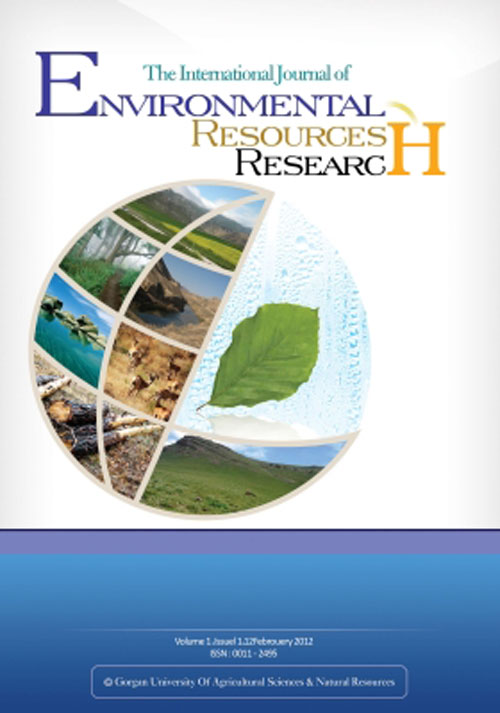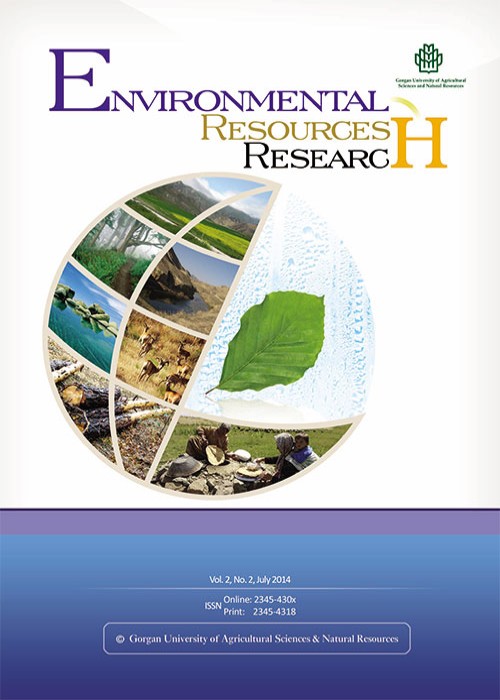فهرست مطالب

Journal of Environmental Resources Research
Volume:2 Issue: 1, Summer - Autumn 2014
- تاریخ انتشار: 1392/11/18
- تعداد عناوین: 8
-
-
Pages 233-246Hydrologic regime is highly dependent on climate change, as hydrologic cycle components are directly influenced by climatic conditions. This paper analyzes the impacts of climate change on the hydrologic regime of the Atrak River basin in the northeast of Iran. It drains to the Caspian Sea. The data collected at 11 hydrometeorological stations were examined to detect trends in hydroclimatological variables. Ten variables including annual mean discharge, annual maximum discharge, annual precipitation, maximum daily precipitation, annual minimum, mean and maximum temperatures, diurnal temperature range, annual pan evaporation and annual potential evapotranspiration during 1975 – 2008 were analyzed using the non-parametric test of Mann-Kendall. First, the long term observations of annual mean discharge at 8 hydrometric stations have been analyzed to find out any indication of increasing or decreasing trend. Second, the long term records of precipitation, temperature, pan evaporation and potential evapotranspiration were examined to detect signs of climate change. Finally, the relationship between trends in streamflow and meteorological variables were discussed. The results indicate that although the annual mean discharge at all stations across the Atrak River basin is decreasing, but it is statistically significant at 6 stations (75 percent of stations). However, there is no evidence of significant increasing or decreasing trends in the precipitation variables. Analyses on temperature and evaporation variables show increasing trends in most of the stations. Therefore, it is concluded that decreasing trends of annual mean discharge is most likely related to an increase in the evaporative power of atmosphere.Keywords: Atrak, climate change, discharge, Mann, Kendall, trend analysis
-
Pages 247-252The leopard (Panthera pardus) as an adaptable felid widely distributed in varied ecosystems of Iran. The Golestan Natural Park is one of the main habitats of leopard in the country. It has divers diet and preying various types of preys such as wild ungulate and livestock. The prey remains’ samples of leopard were collected and preserved using ethanol 96% and whole genomic DNA was extracted. The Control region of mtDNA was PCR-amplified using primers L15995 and H16498. In this study, we identified domestic dog (Canis lupus familiaris) in diet of leopard in Golestan National Park by means of sequencing the control region of mtDNA. It is the first record that reveals domestic dog in the diet of leopard in Iran, although many different preys have been detected in other studies except dog. Existence of dog in leopard’s diet is remarkable while many favourite preys of leopard exist in the same habitat.Keywords: Diet analysis, Control region, Leopard, Golestan National Park
-
Pages 253-262The fact that water is the most important factor of life on earth is not a new concept. Alteration and reduction in the amount of precipitation, population explosion and contamination of underground water pressurize governments severely to find solution for water resources. The air moisture is one of fresh water resources which has not been noticed and well exploited. In this study proper places were identified for dew harvesting in Iran based on three important aspects: relative humidity, wind speed and the number of sunny days. The province centres was considered as a whole indicator. Areas with an average relative humidity of more than70%, wind speed less than 3m/s and the sunny days were the best sites for dew harvesting. Based on comparisons and available maps generated from Arc-GIS software, the Coastal provinces in north and south of Iran including Golestan, Mazandaran, Gilan, Bushehr and Hormozgan whichcomprise about 17% of the total area of the country were identified to be suitable for this purpose. However Bushehr and Hormozgan provinces were mostly suitable compared to others regions due to extended sunny days.Keywords: Arc, GIS, dew harvesting, relative humidity, wind speed
-
Pages 263-274Forest types mapping, is one of the most necessary elements in the forest management and silviculture treatments. Traditional methods such as field surveys are almost time-consuming and cost-intensive. Improvements in remote sensing data sources and classification –estimation methods are preparing new opportunities for obtaining more accurate forest biophysical attributes maps. This research compares performance of three non-parametric and tree-based algorithms i.e. the Classification and Regression Tree (CART), Boosting Regression Tree (BRT) and Random Forest (RF) for general forest type mapping using semi high resolution of SPOT-HRG data. Using a systematic random sampling design in a small area of the Hyrcanian forests, tree and shrubs species were registered in 150 sample plots. The general forest types of plots were named based on frequency of dominant species methods. After geometric and atmospheric corrections of SOPT-HRG data, suitable image processing transformations were applied on main bands to produce general vegetation indices and principal components. A wall-to-wall forest type classification of processed bands was done using three nonparametric algorithms. The forest type maps were assessed using unused test plots. Results shows that RF algorithm compared to CART and BRT algorithms with overall accuracy of 70% and kappa coefficient of 0.63 could better classify the forest stand types, while the CART method had the lowest accuracy with overall accuracy of 60% and kappa coefficient of 0.51. A performance result of the BRT classifier shows that their result is slightly similar to RF classifier.Keywords: Forest types classification, Tree, based algorithms, Hyrcanian forest, SPOT, HRG
-
Pages 279-288Nowadays, drought is considered as damaging environmental phenomenon which affects natural resources and social communities. Therefore it will be an important issues that magnitude and effects of these phenomena to be considered. To do this we used L-moment method for regional homogeneity testing. The Streamflow Drought Index (SDI) index was used as a hydrologic drought for investigating probability of drought occurrence in Halilud basin as one of important basins in arid and semi arid regions of Iran which annually suffers form drought damages. Results showed that drought magnitude renege is varied form mild to sever form across basin form upstream to downstream. In other hand frequency of drought occurrence is concentrated in southern of basin. Results also showed high correlation between Standardized Precipitation Index (SPI) as a meteorological index with hydrologic index (SDI).Keywords: hydrological drought index, SDI, SPI, Lmoment, Halilrud basin
-
Pages 289-298We studied litterfall dynamic of tree plantations in Dez River floodplain, at 14 to 15 years old. The plantations consist of Populus euphratica Oliv., Eucalyptus camaldulensis Dehnh., E. microtheca F. Muell, Acacia farnesiana (L.) Willd., A. salicina Lindl., A. saligna (Labill.) H. Wendl., A. stenophylla Benth. and Dalbergia sissoo Roxb. Litterfall was different between the tree species, and leaf litter fall was the dominant part, while reproductive and woody parts have considerable amounts in some species. The results also showed that most of the everegreen and deciduous trees litterfall were in Jun and October, respectively. Day length and maximum and minimum temperature controlled the litterfall of some species. Totally we could state that although leaf litter is the most part of litterfall, reproductive and woody parts have also considerable amounts in some species e.g. woody parts in Eucalyptus species. Also the obvious differences of litterfall fractions between the different species confirmed that the litterfall fractions should be considered in studying nutrient cycling.Keywords: Litter Production, litterfall dynamic, Climatic factor, Plantation
-
Pages 299-308Planting shrub seedlings under oil mulches has frequently been used for stabilizing mobile sands in Iran for during the last three decades. Sandy desert of Samad Abad, Sarakhs, northeast Iran, has been fixed by cultivating seedling of Haloxylon aphyllum under the oil mulches. Therefore this study was designed to investigate the effects of the sand fixation project on soil and vegetation properties. Vegetation samples were taken in a randomized-systematic method from representative areas of the rehabilitated and control sites. At each site, nine transects, 50 meters length, were established. Canopy cover and density of two dominant shrub species (Astragalus squarrosus and Convolvolus hamadae) as well as the total canopy cover of their understory plants were measured, along the line transects. In each area, 220 individuals of each shrub (above mentioned) were selected and their total and living aerial foliage volumes were measured. Moreover, in each area, four soil samples were taken from 0-20 and 20-80 cm depths. The percentage of organic matter were measured in soil samples. Data analysis was done using independent T-test. According to the results of this research, application of oil mulched and Haloxylon plantation caused a significant reduction in the percentage of total canopy cover of A. squarrosus and density of A. squarrosus and C. hamadae but it increased the living aerial foliage volume of A. squarrosus and C. hamadae.Keywords: Oil mulch, Haloxylon aphyllum, Vegetation rehabilitation, Organic matter, Sarakhs
-
Pages 309-326The results of an integrated study aimed at restoring water quality in a large watershed including seven catchments in north east Iran are presented in this paper. This case study demonstrates how landscape metrics reflect direct or surrogate causes of the land use practices that are the determinants of water quality parameters. Water quality factors included EC, pH, Cl-1, HCO3-1, SO4-2, Mg+2, Ca+2 and Na+1 measured over the period 1988 - 2005. Forty-six spatial metrics of the catchments were computed using available GIS layers and MODIS and Landsat TM imagery. Based on a correlation analysis, the 46 parameters of the catchments were reduced to 14, and these were correlated with the eight water quality factors. Of the catchment variables, 10 were found correlated to water quality factors. Among these, 8 are modifiable and watershed managers should be able to alter these factors to restore water quality. As the first study of this kind in Iran, further applicability of the method and its importance in water quality management through quantitative metrics of landscape is outlined and the procedures to adopt in future studies for proposing restoration actions in the study area is demonstrated.Keywords: Modeling, Landscape, Water Quality Management, Rehabilitation


